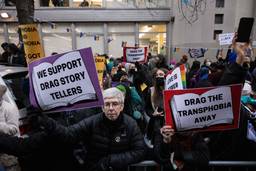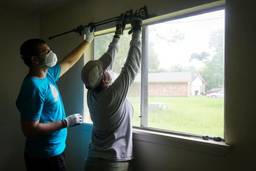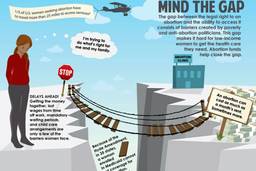What We Can Learn From the “Janes” of the 1960s Underground Abortion Network
Rather than despair, abortion advocates should learn from a long, radical history of community organizing and mutual aid.
Eesha Pandit

In 1969, four years before the Supreme Court would legalize abortion in the United States, a group of women founded the Abortion Counseling Service of Women’s Liberation — or “The Service” as its members called themselves — a clandestine band of abortion access warriors.
Members of The Service counseled women and referred them to an underground network of abortion providers, each vetted and screened to ensure that they were reliable and competent. When women called to get information and support in accessing a safe abortion they asked for Jane. Each of the women who volunteered as a “Jane” knew the precarious position they were in.
Laura Kaplan was part of The Service, also known as Jane, from 1971 until 1973. “I remember a young woman telling me about the doctor and the nurse talking over her head,” she says. “This was during her legal abortion, after 1973. Our work with The Service was so different. We would talk to the women that called us. We would share all the information we had, and tell her everything she wanted to know. This was part of how we worked, education and empowerment, for her and for us.”
After realizing that at least one doctor they had been referring women to was not, in fact, a licensed physician, the women involved in The Service asked themselves one question that would change everything: If he could provide safe abortions without a license, why can’t we? Thus began a shift in the women’s work, refusing to rely on traditional physicians to provide abortion care while choosing to roll up their sleeves and do it themselves.
There is perhaps no better time than now to look back at this history as we consider the future of abortion access in the United States. Each year, abortion rights activists and opponents alike spend January 22nd debating the protections afforded by the Supreme Court’s 1973 ruling in Roe vs. Wade. And each year, tallies are made: How many new abortion restrictions are on the books? How many bills are awaiting their fate in the courts? All leading to the big question: Is the repeal of Roe a possibility?
On this anniversary, we should turn to the fortifying lessons from the time of Jane that may be instructive for abortion advocates. With conservative justice Brett Kavanaugh now sitting on the Supreme Court, many have argued that it’s a matter of when, not if, federal abortion protections will be repealed. This worry is leading some abortion advocates to fear an impending retreat into the proverbial back alley.
But let us not rush to that scenario, just yet. We should instead take some time to remember what we know about abortion access and how to achieve and protect it.
Loretta J. Ross, a longtime activist and one of the Black women who created the reproductive justice framework itself, writes about another important reminder for these precarious times. “[The] Reproductive justice [framework] helps close the gap between these siloed oppressions, combining fights against population control, white supremacy and neoliberal policies like the policing of welfare recipients,” Ross says. “With Roe under threat and white supremacy resurgent, reproductive justice could be the conceptual glue for the collective movement against the intersectional web of racism, white supremacy, eugenics, classism and heteropatriarchy.”
Amanda Williams, Executive Director of Texas’ Lilith Fund, keeps Roe in context, reminding us that, “For decades, people seeking abortion in Texas have been living in a reality in which Roe has never actually been enough.” Indeed, abortion funds like The Lilith Fund operate to meet an unmet need — access to abortion for those who cannot afford it. This distance between legal and accessible is a gap that volunteers around the country work to bridge.
And that’s the place to start, says Kaplan, when asked what she thinks would be most useful in the event of a Roe repeal, “Start with what you can do right now. This is how The Service evolved from a group that referred women to providers, to a group of women who became providers themselves.” She rejects the idea that the women of Jane were superheroes, bristling at the suggestion. “People don’t need stories of superheroes, they need to hear stories about ordinary people with their foibles and their fears, organizing together despite those things.” Kaplan’s book, The Story of Jane, does just this.
Williams reminds us that local organizers often are the closest to the problems, as well as the solutions. “The experiences of our clients — who are primarily low-income parents of color — inform the ways in which we transform our work over time,” Williams says. “The primary way to prepare for our future, whether Roe is gutted or overturned entirely, is to look to the expertise of those most impacted by systems of oppression and discrimination. Only with the leadership of these communities can we build the collective vision that will be the key to liberation for all.”
While access to abortion remains limited for so many, despite the legal protections, things have also changed in the 46 years since the Roe ruling. As people seek reproductive healthcare options that are affordable, accessible and private, they can turn to a range of reproductive health technologies. Some of these are new, like access to effective abortion pills. And some are old, like access to those who use methods passed down from generation to generation about how to end a pregnancy.
Our work, now, must ensure that people seeking to end a pregnancy are not criminalized while looking around our own communities to find ways to plug in and bridge the gaps between legal and accessible abortions.
We must also take a deep breath, learn about the work done by women of color leaders under heavy surveillance as they organized their communities in the 60s, and the brave work of those Janes who learned to provide the care themselves. We should be heartened by their legacy, knowing that there are a great many still carrying it forward today.
Hearing from young leaders like Williams alongside longtime activists like Ross and Kaplan is fortifying for the months and years of work ahead not because they are telling us that Roe is safe, but because they’re telling us that even though we know it’s not, we also understand where to look for leadership to carry us through: Ourselves and each other.
Eesha Pandit is a Houston-based writer, activist and freelance consultant who believes in social justice movements, the power of intersectionality, feminism, sisterhood and the power of collective action.
Her writing can be found at Crunk Feminist Collective, Feministing, Salon, The Nation, RH Reality Check, Feministe and In These Times. She has also appeared on numerous TV news outlets including CNN, HLN, MSNBC and Grit TV with Laura Flanders.








